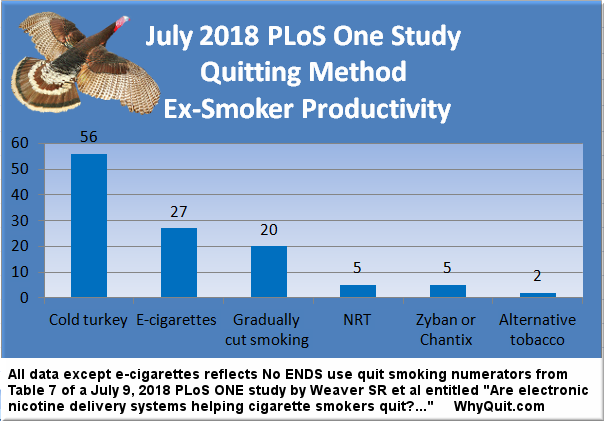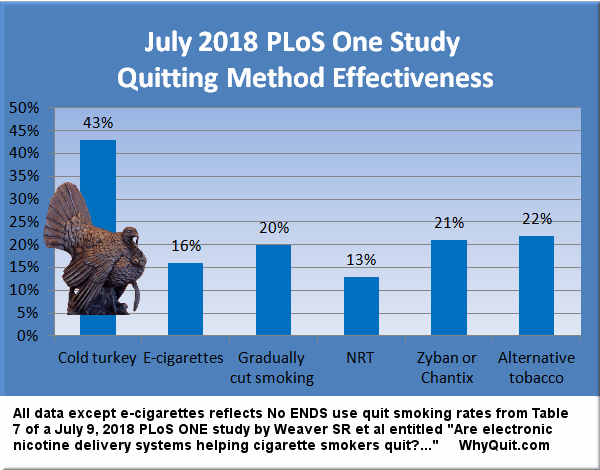
Cold turkey clobbers e-cigs, NRT and Chantix
Cold turkey generating 11 times more ex-smokers than NRT in this study of 374 quitters, has widespread e-cigarette use diminished tolerance of teasingly slow and unsatisfying replacement nicotine?
July 18, 2018 by John R. Polito
Contrary to hundreds of placebo-controlled clinical trial findings and billions spent on three decades of Nicorette "crave relief" marketing, cold turkey has remained the real-world quitting champion every year since invention of commercial cigarettes 153 years ago in Raleigh, North Carolina. The burning question is, has arrival of e-cigarettes changed things?
A Georgia State University study identified 1,284 adult U.S. smokers in 2015. It then attempted to follow-up with them a year later in 2016 to determine how many had quit smoking and how.
Among the 858 who completed a 12 month follow-up survey (66.8% of the original 1,284), 374 or 43% had made at least one attempt to stop smoking completely. Among the 374 who attempted to quit, 112 succeeded: overall a 30% success rate.

Quitting Method Productivity Winner?
So what methods did the 112 who stopped smoking completely use? Which method produced the most ex-smokers? Published online on July 9, 2018 at PLoS One, according to study Table 7, the number of smokers who successfully quit smoking cigarettes by each method were:
- 56 Cold turkey (abrupt smoking cessation without e-cig use)
- 27 Any e-cigarette use
- 20 Gradually cut smoking (without e-cig use)
- 05 Nicotine replacement therapy (without e-cig use)
- 05 Cessation pharmacology (Zyban or Chantix without e-cig use)
- 02 Alternative forms of tobacco (without e-cig use)
As you may have noticed, that adds up to 117. And that doesn’t include 5 successful quitters who received counseling or group support, quitters who are obviously included within one of the above 6 categories.
While I suggest in a comment at the PLoS ONE study site that we are seeing category crossover due to the study’s dependency destroying definition of cold turkey ("gave up cigarettes all at once" instead of the actual definition, "abrupt complete cessation of the use of an addictive drug"), Table 7 footnotes indicate that there was also "missing data."
Regardless, cold turkey crushed the competition. And its ex-smoker productivity victory is bigger than the numbers suggest. Why? Because successful cold turkey stops and eliminates the infliction of additional harm instead of reducing it. While harm reduction is critical to saving lives, it must never be given higher priority than harm elimination.
Cold turkey quitters fully arrest their chemical dependence while most e-cig users remain hooked, using and a power failure away from searching for the nearest nicotine delivery device.
As for nicotine gum, a March 2003 study combined and averaged seven U.S. over-the-counter nicotine patch and gum studies and found that just 7% of users were still not smoking at six months, a 93% failure rate. The same primary authors published a November 2003 "persistent use" study which found that nearly 7% of nicotine gum quitters were still chewing nicotine gum at six months."
With so many nicotine gum quitters ending up hooked on the cure, the gnawing question has been, is it possible for a nicotine addict to arrest their dependence upon nicotine while chewing it? A 2013 Gallup Poll found that only 1 in 100 successful ex-smokers credited nicotine gum for their success.

Quitting Method Effectiveness Champion?
While the new PLoS One study found cold turkey the most productive quitting method, which method had the highest quitting rate?
- 43% Cold turkey without any e-cig use (56 of 129)
- 22% Alternative forms of tobacco without e-cig use (2 of 9)
- 21% Zyban or Chantix without any e-cig use (5 of 24)
- 20% Gradually cut smoking without any e-cig use (20 of 99)
- 16% Any e-cig use (29 of 177)
- 13% Nicotine replacement therapy without any e-cig use (5 of 38)
While appearing to be extremely high quitting rates, the above findings are strikingly similar to pre-ecig and Chantix era rates seen in the 2006 Doran study which followed the smoking patients of 1,000 Australian family practice physicians. It found that from 2001-2003, that cold turkey generated a 40.2% rate, while Zyban was at 20.8%, nicotine gum at 11.4% and the patch at 21.5 percent.
In the Doran study, without e-cigs or Chantix in the picture, cold turkey accounted for 1,942 of 2,207 former smokers, or 88% of all success stories. In the new PLoS ONE study, 47% of quit attempts involved e-cigarette use (177 of 374), which were 2.5 times less effective than cold turkey (16.3% vs. 42%).
The obvious and glaring question becomes, are e-cigarettes diverting and keeping hooked smokers who would have otherwise fully and successfully arrested their chemical dependence?
Here, by far the most productive and effective method, what’s shocking is that the study’s abstract (summary) doesn’t once mention cold turkey. It’s in large part why this review is necessary.
Maybe the title of the study has something to do with why the clear winner isn’t mentioned. It’s entitled, "Are electronic nicotine delivery systems helping cigarette smokers quit? Evidence from a prospective cohort study of U.S. adult smokers, 2015-2016."
Yes, as indicated by Table 7, the study’s primary focus was e-cigarettes. Close exam of Table 7 indicates that my above productivity and effectiveness conclusions lump all electronic nicotine delivery system (ENDS) use together, while the study breaks e-cig use down into 10 categories.
Still, putting this study's e-cig findings in the best possible light, the e-cig use category producing the greatest number of ex-smokers was "Cold Turkey" with 16 (again, defined as "gave up cigarettes all at once"). Using this study’s bastardized definition of cold turkey, e-cigs would have placed 4th in ex-smoker productivity.
What about the most effective e-cig category? There, "Switched Completely to ENDS" resulted in 12 of 56 e-cigarette users (21 percent) quitting smoking. That would have placed it a distant 3rd in effectiveness, tying with cessation pharmacology (Zyban and Chantix).
Apples to Oranges
Harm reduction aside for a moment, imagine comparing the accomplishment of an alcoholic who abruptly and completely stopped drinking, to one who traded their bottles and cans for alcohol IV bags.
It’s the same "real quitter" vs. "still using" issue that contributed to making the findings of more than 200 placebo-controlled NRT studies sadly laughable.
There, worse than continuing-nicotine-use bias, NRT researchers discovered in the very first nicotine gum studies that it was impossible to blind experienced quitters as to the presence or absence of their withdrawal syndrome. The more quitting attempts the smoker had made, the more expert they became at recognizing it.
If you’d joined a quitting study in hopes of receiving weeks or months of free pharmaceutical-grade nicotine, would your hopes have been dashed when you realized that you’d been given a nicotine-free placebo instead?
Are E-cigs Changing Urge Satisfaction Expectations?
Has arrival and gradual improvement of e-cigarette technology created heightened smoker expectations that vaping is superior to slow acting nicotine gum or the transdermal patch in satisfying the smoker’s need for more nicotine?
In the PLoS One study, 40% of responding smokers had tried vaping (197 of 486 - see Table 3). But do you need to have tried e-cigs before your expectations begin changing? Like learning about God, is it possible that meeting, being taught by, and questioning an e-cig user could influence and alter your entire spectrum of nicotine delivery beliefs?
Here, among this study population, cold turkey proved 3.3 times more effective and a whopping 11 times more productive than NRT. Like demise of the horse and buggy, could it be that the same enslaved dopamine pathways that helped replacement nicotine appear superior in more than 200 randomized clinical trials are today, ironically, contributing to its demise?
100% Odds of Success
Founded in 1999, WhyQuit is home to smart turkey quitting. And it isn't complicated. In fact, there's only one guiding principle determining the outcome for all. It's called the Law of Addiction. It tells us that it is impossible to relapse so long as all nicotine remains on the outside.
Yes, there is only one rule: commitment to never taking another puff, dip vape or chew!

